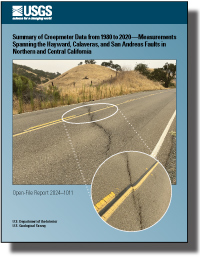Summary of Creepmeter Data from 1980 to 2020—Measurements Spanning the Hayward, Calaveras, and San Andreas Faults in Northern and Central California
Links
- Document: Report (60 MB pdf)
- Download citation as: RIS | Dublin Core
Abstract
This report is an update to the presentation by Schulz (1989) introducing potential users to the creepmeter data collected between the publication of Schulz’s report and mid-2020. The creepmeter network monitors aseismic, surface slip at various locations on the Hayward, Calaveras, and San Andreas Faults in northern and central California. There are different designs of creepmeters and these are briefly described. For a majority of the creepmeters, these data are automatically sent to the U.S. Geological Survey (USGS) offices where they are stored and processed. In addition, for most of the creepmeters, occasional manual measurements are made and these are compared with digitally recorded data. For some sites, the comparisons indicated degradation of the electronic sensor and consequently corrections are made to the digital data. The largest transient deformation is that which followed the 2004, M6, Parkfield earthquake. Various functions found in the literature that have been used to model postseismic slip were tested with the observed postseismic behavior seen on the creepmeters in the vicinity of Parkfield, California. No single function adequately fit all the data from these Parkfield instruments. This report is a discussion and analysis of data from creepmeters deployed by the USGS. The discussion primarily focuses on instruments that are currently operating in 2020 or have operated quite recently but are no longer in service.
Suggested Citation
Langbein, J., Bilham, R.G., Snyder, H.A., and Ericksen, T., 2024, Summary of Creepmeter Data from 1980 to 2020—Measurements Spanning the Hayward, Calaveras, and San Andreas Faults in Northern and Central California: U.S. Geological Survey Report 2024–1011, 110 p., https://doi.org/10.3133/ofr20241011.
ISSN: 2331-1258 (online)
Study Area
Table of Contents
- Abstract
- Introduction
- Instrumentation, Methods, and Data; Data Summary
- Parkfield Postseismic Creep
- Discussion
- References Cited
- Appendix 1. Site Summaries for Creepmeter Sites for the Hayward, Calaveras, and San Andreas Faults in Northern and Central California
- Appendix 2. Calculation of Fault Slip from Creepmeter Data—Effect of Obliquity and Fault-Normal Displacements
- Appendix 3. Creepmeter Calibration Issues Addressing the Potential Scaling Problem for the Gold Hill (XGH1) Creepmeter Located on the San Andreas Fault Southeast of Parkfield, California
- Appendix 4. Seasonal Variations in Creep for the Hayward, Calaveras, and San Andreas Faults in Northern and Central California
- Appendix 5. Creep, Earthquakes, and Strain for the Hayward, Calaveras, and San Andreas Faults in Northern and Central California
- Appendix 6. Earth Tide Effects on Selected Creepmeters in Northern and Central California
- Appendix 7. Propagating Creep Events for Selected Creepmeters in Northern and Central California
| Publication type | Report |
|---|---|
| Publication Subtype | USGS Numbered Series |
| Title | Summary of Creepmeter Data from 1980 to 2020—Measurements Spanning the Hayward, Calaveras, and San Andreas Faults in Northern and Central California |
| Series title | Open-File Report |
| Series number | 2024-1011 |
| DOI | 10.3133/ofr20241011 |
| Publication Date | March 18, 2024 |
| Year Published | 2024 |
| Language | English |
| Publisher | U.S. Geological Survey |
| Publisher location | Reston, VA |
| Contributing office(s) | Earthquake Science Center |
| Description | vi, 110 p. |
| Country | United States |
| State | California |
| Online Only (Y/N) | Y |


